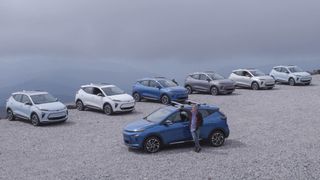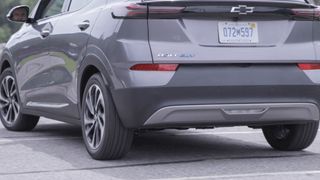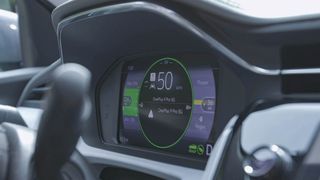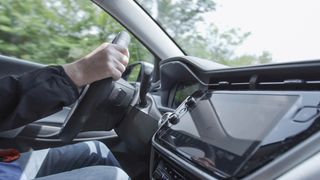Tom's Guide Verdict
A serious contender for anyone considering an EV or daily commuter, the Chevy Bolt has some great technology updates but is currently crippled by a battery recall on all models.
Pros
- +
Peppy commuter with good range
- +
Leading semi-autonomous driver assist tech
- +
Solid handling
Cons
- -
Ongoing battery recall on all models
- -
No all-wheel drive option
Why you can trust Tom's Guide
Release date: Available now
Price: From $27,200; $43,190 as tested
Power: Single motor, Front wheel drive
Horsepower: 200 hp
Battery range: Up to 247 miles
0 to 60 mph: 7 seconds
Top Speed: 95 mph (limited)
Smarts: Android Auto, Apple Carplay, OnStar, and Chevy's MyLink system
The Chevy Bolt EUV is a great car, hampered by the shadow of the extensive battery recall. While the battery issues are now well and truly over, as best as we can tell, The Chevy Bolt EUV and the regular Bolt might be a tough sell for some EV-sceptics. Good thing the price tag has taken a pretty-steep dive.
The Bolt can be bought from $25,600, while the Bolt EUV begins at $27,200. That means both cars undercut the cheapest Nissan Leaf model at retail, though Nissan still gets to enjoy the $7,500 federal EV tax credit for the time being.
That might be enough to tempt you behind the wheel and discover just what the 2022 Chevy Bolt EUV can do. The car's performance is pretty solid on highways, city streets and mountain roads. It also comes loaded with plenty of technology, including GM's semi-autonomous Super Cruise system — a first for Chevrolet. Had it not been for the recall, it may have earned itself a spot on out list of the best electric cars several months back.
2022 Chevy Bolt EUV review: Trims and availability
The Chevy Bolt EUV may not be the most strikingly designed or attractive compact EV on the market, but this latest iteration of the car is a major step up from earlier models. It has a more aggressive front end, with less of a slope than the standard Bolt, as well as being three inches wider and six inches longer than the standard model.

The Bolt EUV is available in two trim packages: LT, starting at $27,200, and Premier, starting at $31,700. Both models are rear wheel drive, and there’s no all wheel drive model on offer.
Our test model had the Premier package. It includes a full array of state-of-the-art safety technology, such as adaptive cruise control and a 360-degree video view for tight parking situations. There's also pedestrian warning and braking, lane-keeping assist and a rear camera mirror. The last item uses a rear hatch-mounted camera to display what's behind you on a screen in the rear view mirror. It eliminates all potential rear view blind spots, so you can load up the back seat and still see what's behind you.

Optional packages include a $2,495 audio and sun-roof package that includes a beefed up navigation system and 7-speaker Bose sound system. The Super Cruise option, GM's hands-and-feet-free driver assistance package, is only available on the EUV. And it's a $2,200 option.
In case you're wondering where the Bolt EUV stands compared to the industry leader, Tesla, the base EUV model starts at $33,995 while the Tesla Model 3 Standard Range Plus starts at $41,190 — a $7,195 difference.
2022 Chevy Bolt EUV review: Interior and features
The interior of the Bolt EUV, while not plush, is solid and comfortable. Our Premier edition included leather-appointed ventilated and heated front seats, plus the panoramic glass roof option that gave the interior a more expansive feel.

The big improvement inside, however, is the additional room for rear-seat passengers. There's a little over three inches of extra leg room back there now, and while this doesn't sound like a lot, it makes a significant difference — even on short trips.
The premium optional sound system in our tester was powerful enough to rattle your teeth and delivered that distinctive mid-range biased Bose sound. The Bolt EUV center console includes a wireless charging pad and Chevy's MyLink infotainment system is well laid out and easy to follow.
Other features include built-in navigation, along with OnStar for 3 years, and the 10.2-inch touch screen is large enough to be taken in with a glance. The system also supports Apple CarPlay and Android Auto (take that, Tesla), giving you the option of using familiar smartphone apps, or barking at the Bolt's built-in voice control system. The car doesn't have 5G, but there is 4G LTE connectivity that you can use to create a Wi-Fi hotspot for up to 7 devices.

The MyChevrolet app (available on iPhone and Android) that offers several features including remote start, charging status, and reports on driving habits, if you so choose.
Most noteworthy is the availability of GM's Super Cruise. Previously this tech was only available on Cadillacs, making the Bolt EUV the first Chevy and first EV to include the hands-free driver assistance package.
Unlike offerings from other manufacturers, Super Cruise is designed to be operated completely hands-free. It will handle driving tasks on over 200,000 miles of divided highways in the U.S. and Canada that have been mapped in advance with a 3D lidar system. Super Cruise then uses those downloaded high-res maps in conjunction with its built-in GPS, camera, and radar sensors to precisely direct the vehicle down the road. All you have to do is keep your eyes open and look ahead. It's a system we've tested extensively since its introduction, and while not perfect, it represents a state-of-the-art semi-autonomous system that is a welcome companion on long road trips.
2022 Chevy Bolt EUV review: Test drive
In spite of its name, the Bolt EUV is still a small car. But GM has improved this hatchback not only in the sophistication of its technology, but also in its ride and drive. On the highway, it feels solidly entrenched in the lane and the steering is adjusted to give the 17-inch wheels a stable feel you’d normally only experience in a much larger vehicle. Of course the electric powertrain gives the Bolt EUV some extra pep, meaning you can confidently merge onto the highway and pass trucks with ease.

City streets are the Bolt's natural environment, where it will zip ahead of other cars at green lights (0 to 60 mph in 7 seconds isn't bad), with its predictable handling and compact size making the car easy to handle in traffic and parking situations. And when we made one unintended near-off-road excursion on an unmaintained mountain road, the Bolt EUV kept its composure as we circumnavigated minor sinkholes and buckled pavement.
One day, we started out with about 230 miles of range and headed up the winding drive that threads its way to the summit of New Hampshire's Mount Washington. The extra effort ascending the 6,288-foot mountain dropped our range to about 188 miles--but on the way down, we got nearly all of that range back, thanks to regenerative braking and the Bolt EUV's one-pedal driving mode.

Available on many EVs, one-pedal driving allows the car to fully deploy its regen braking, which converts the heat from braking into electrical energy to recharge the battery. This system also starts slowing the car the second you take your foot off the gas and can bring the car to a complete stop. You don't even need to put your foot on the brake to hold your car in place
We found the Bolt's one-pedal braking worked smoothly, though some systems can be too rough and difficult to master. It takes practice to accurately estimate when you should lift your foot to bring the car to a complete stop at a light. But we found Bolt's one-pedal mode one of the easiest to use, and once you're used to one-pedal driving, you'll never want to go back.

For most of our highway driving we stayed in Super Cruise mode. You set the system by engaging adaptive cruise control, centering the car in your lane, and pushing the Super Cruise button. Once the steering wheel goes green you can let the car take control.
2022 Chevy Bolt EUV review: Super cruise
An infrared camera on the steering column keeps an eye on you and if you look away for longer than a couple of seconds, become drowsy or block the camera's view, the system will flash warnings. If there's no response, the system will slow the car down in its lane and come to a complete stop. If there's still no response from the driver, OnStar will place an emergency call.
On highways in two states, riding with Super Cruise was pleasantly uneventful. It negotiated curves, hills and traffic entering and exiting our lane without trouble. However if you want to exit the highway, you have to retake manual control.

Some drivers may find it unnerving to allow the car to pass semi-trucks going 65 mph, but one grows more confident the more one uses Super Cruise.
We've driven cars with Super Cruise in several states without experiencing any significant interruptions. However, New Hampshire delivered a number of surprises. The Bolt EUV handed back control in the middle of several stretches of I93, for example, even when there were no apparent breaks in the lane markings or obstructions.
While some may find such interruptions troubling, we found it reassuring since it demonstrates the multiple levels of redundancy that GM uses to make Super Cruise as accurate and safe as possible. If any of the subsystems—lidar maps, radar, or video cameras—experience a problem, the system alerts the driver and hands back control. So unlike some other semi-autonomous systems, it is never guessing about what's ahead.

We did have one minor hiccup heading north on I93 when a large distinct shadow created by an overpass caused the car to suddenly brake, but then just as quickly release, like a hiccup. We've seen the same reaction in systems from other automakers including BMW and Volvo, indicating that the technology has yet to be perfected.
Furthermore, the challenges of handing control back to the driver became apparent. After driving for, say, an hour using Super Cruise and being alerted with a red light and audible warning to re-take control, we felt we usually had sufficient time to comfortably take the wheel again — with one caveat.

If you take control and then leave the car in adaptive cruise mode, but not Super Cruise mode, it's easy to forget and take your hands off the wheel, as if it were still in semi-autonomous mode. That's a habit that will be hard to break as such systems become more prevalent.
Lastly, there are two differences between the Super Cruise package available on Cadillacs and the one on the Bolt EUV. First, while the latest version for Cadillac will automatically change lanes on the highway, the Bolt EUV makes you do it yourself and wait for the green light to indicate it’s safe to take your hands off the wheel again. Second, Super Cruise like other systems tends to steer you down the center of a lane. The Cadillac version will let you adjust exactly where the car sits in the lane, which isn’t the case on the Chevy Bolt EUV.
2022 Chevy Bolt EUV review: Battery and range
The Bolt EUV's battery is obviously the locus of attention right now because of the recall. Fortunately, we had no problems during our testing days. The car uses a 65 kWh lithium ion battery under the floor, which affords the EUV a 247-mile range.

That’s fairly competitive with the Kia Kona (258 miles) and the Tesla Model 3 (262 miles, standard) and the Volkswagen ID.4 (260 miles). Better still, we found its in-dash range estimates to be accurate overall.
Normally, you just charge the car using its standard J1772 port, but just in case you find yourself far from an EV charger, GM throws in a new dual level charge cord that lets you plug into a standard 120-volt outlet. However, the 120-volt plug should only be used in emergencies since it only adds four miles of range per hour.
On a standard Level 2 AC charger (like a home or public charger), it takes 7 hours to fully charge the car, which is typical these days. Meanwhile the Bolt EUV supports up to 55kW DC rapid charging, which adds 95 miles of range in 30 minutes. Which honestly isn’t great, and many cars now support much faster speeds, including Tesla with its 250 kW Superchargers.

To help you plan for longer trips, the MyChevrolet app will locate available charging stations. You'll also see real-time status from EVgo and ChargePoint stations along your route in the app. At some EVgo stations you can even automatically pay directly from the app.
2022 Chevy Bolt EUV review: Verdict
Purely on price and performance the Bolt EUV represents a good value. The base EUV starts at $27,200, while the Tesla Model 3 Standard Range Plus starts at $46,990. That's a difference of almost $20,000.
Even if you want all the tech GM offers--a decision we recommend--you need to get the top Premiere trim on the Bolt EUV plus the $2,200 Super Cruise option. Then again Tesla’s ‘Full Self Driving’ option costs an extra $12,000 on top of the list price.
The manufacturing defect in LG's batteries that suspended production for so many months was a darn shame considering how much we liked driving the new Chevy Bolt EUV. It is a very capable commuter that deserves attention from anyone looking for a solid city car. And the market deserves to have more electric options.
John R. Quain has been reviewing and testing video and audio equipment for more than 20 years. For Tom's Guide, he has reviewed televisions, HDTV antennas, electric bikes, electric cars, as well as other outdoor equipment. He is currently a contributor to The New York Times and the CBS News television program.


